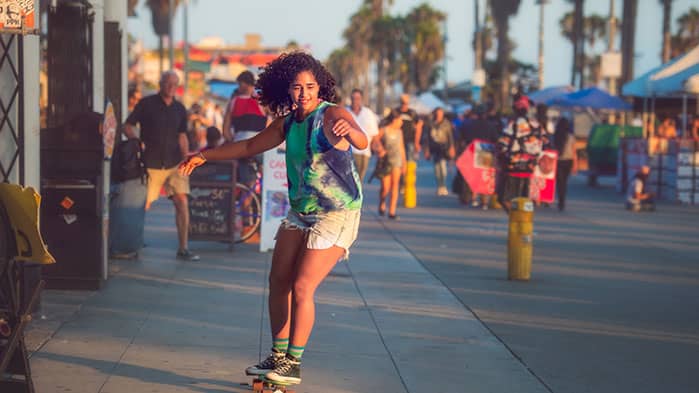Los Angeles
ADVERTISEMENT
ADVERTISEMENT
ADVERTISEMENT
Los Angeles can be a difficult city to crack because of its sprawl and size, but it’s full of hidden gems if you know where to look.
Given the city’s role as the global hub of entertainment, you may end up rubbing shoulders with the rich and famous at a juice bar or hiking the popular Runyon Canyon.
Music festivals, hole-in-the-wall bars and restaurants, abundant farmers markets, public parks, beaches, and free events like the popular CicLAvia street festival are popular with local Angelenos, and can be a great introduction to the city. Here’s what you need to know about the City of Angels before considering a move.
Discover what
Los Angeles has to offer
-
Neighborhoods
ExpandHollywood may be a bit of a tourist trap, but its nightlife and epic farmers market every Saturday can make it an exciting destination for newcomers who want to be close to the center of the entertainment history.
Neighboring West Hollywood is another party destination, a city known in the LGBTQ+ community as the place to see and be seen. East Hollywood offers a more mellow and affordable alternative to the Hollywood lifestyle, while Melrose Avenue is a hip shopping destination where you’re likely to share cafe space with other creatives working remotely on their laptops.
Downtown LA and the adjacent Arts District used to be deserted after work hours. But chefs, fashion designers, artists, and small business owners took advantage of the abandoned historic buildings and warehouse space to make a creative haven. Now, the area is known for its bustling street life. If you don’t want to join the throng of LA traffic every day, downtown may be the easiest place to live due to its walkability and easy access to public transit.
A stone’s throw from downtown, Koreatown is popular with young Angelenos because it has the city’s densest concentration of late-night activities like clubs, Korean barbeque restaurants, and karaoke bars. Founded by Korean immigrants, the neighborhood is a melting pot of languages, cultures, and food. Make sure your apartment building comes with a parking space as street parking is difficult to find.

The Westside region of Los Angeles (or just the “Westside,” as locals call it) is closer to the Pacific Ocean and includes upscale, suburban neighborhoods like Brentwood, Beverly Hills, and Belair, while Mid-City has plentiful dining and shopping options and apartments for rent.
Santa Monica which, like Beverly Hills, is technically its own municipality, can get packed with beachgoers, although the quieter stretches further from the boardwalk are popular with families. Venice, home to the famous Muscle Beach, has a more bohemian vibe even as it attracts the tech industry and media conglomerates. Mar Vista, a few kilometers inland, is a modest suburban community of single-family homes, but a short drive or bike ride away from Venice.
Culver City, technically its own municipality that is surrounded by the city of Los Angeles, is further inland and considered an affordable way for singles or families to enjoy the perks of the Westside.
The Eastside of Los Angeles has plentiful parks, hiking trails, and other green space. A mix of older working class immigrant families, singles, artists, and young families buying their first homes have made Highland Park a trendy neighborhood that still has a quaint, small-town feel.
In Echo Park, a huge, outdoor urban park sits behind Sunset Boulevard, which is dotted with thrift stores, cafes, and dive bars. Silver Lake, the slightly more expensive neighborhood next door, is home to the Silver Lake Reservoir, a 3.5 kilometer trail surrounding a man-made lake.
In south Los Angeles, Baldwin Hills is an upper-middle class neighborhood known as the “Black Beverly Hills.” Primarily residential, the neighborhood has stunning views of the city and an epic park called the Kenneth Hahn State Recreation Area, with trails, sports fields, a Japanese garden, and a lake.
The San Fernando Valley (locals just say “The Valley”) is a huge, arid area with plentiful housing and parking options. Toluca Lake, North Hollywood, Studio City, and Sherman Oaks now have their own respected dining scenes and are ideal places to live if you’re looking for an easy commute to Hollywood. Just make sure your home has air conditioning as the Valley is especially hot and dry in the summer.
Collapse
-
Food & Culture
ExpandNearly every country’s cuisine is represented in Los Angeles.
In the mid-city area, a closely packed strip of Ethiopian restaurants give Little Ethiopia its name. For sushi or shabu-shabu, it’s best to head to Little Tokyo downtown. Westwood is home to some of the city’s best Persian food, while a stretch of East Hollywood houses the only officially designated “Thai Town” in America and is home to incredible restaurants like Jitlada.
The best seafood in the city may come from a food truck. Mariscos Jalisco has served delectable fish tacos in Boyle Heights since 2001, well before the food truck craze took over the LA dining scene. The business has since expanded to three other truck locations, and is beloved by locals and celebrities. Jalisco shouldn’t be your only stop in Boyle Heights, though, as the neighborhood is one of the city’s oldest and has deep ties to the Mexican-American community.
If you insist on sitting down in a restaurant for your seafood, Providence in Melrose is a top fine dining establishment and was a favorite of the late, great LA food critic, Jonathan Gold.
Late at night all over town, you’ll find street vendors hawking bacon-wrapped hot dogs called “danger dogs.” Do not pass them up.
Collapse
-
Education
ExpandThe Los Angeles Unified School District is the second-largest in the nation and is facing financial challenges.
Many parents take advantage of the independent municipalities located within the city of Los Angeles that have their own school districts, such as Culver City, Santa Monica, Beverly Hills, or Pasadena. There are also several exceptional private schools throughout the city, including Harvard-Westlake and Windward.
Los Angeles is home to some of the best universities in the nation, the most famous being the University of California, the University of Los Angeles (UCLA), and UCLA’s crosstown rival, the University of Southern California (USC). The Claremont colleges on the eastern edge of Los Angeles County are small liberal arts colleges that rival the Ivy Leagues in terms of prestige. Top state schools include California State University, Los Angeles (Cal State LA) and California State University, Northridge (Cal State Northridge).
Collapse
-
Healthcare
ExpandLos Angeles is home to dozens of excellent healthcare facilities. The city has some of the best research hospitals in the world, including the teaching hospitals at UCLA and USC. Cedars-Sinai Medical Center is globally renowned for its work in cardiology, oncology, and gastroenterology, while Huntington Memorial Hospital is nationally recognized for its work in neurology and orthopedics.
Collapse
-
Transportation
ExpandIt’s a pain to navigate Los Angeles in a car, with a rush hour at the beginning and end of each day.
Even with the traffic, it’s difficult to enjoy LA without a car. Many new arrivals find that living near your place of work can dramatically improve your quality of life by reducing your amount of time sitting in the city’s snarling congestion.
In some parts of the city, it is also possible to hop on public transit. Since the 1990s, a small but efficient subway takes commuters from Hollywood to Koreatown and downtown. An expanding light rail network connects downtown to both the east and west sides of the county. The bus system is more expansive, though it is typically the slowest way to travel. Bicycle commuting is possible but not for the faint of heart; the city and county have added some bike lanes but the network is limited.
You have a wide selection when it comes to air travel in Los Angeles, with five international airports servicing the LA area. Long Beach, Ontario, Burbank, and Santa Ana are all smaller, regional airports with limited international operations. (As an homage to LA’s Tinseltown history, Burbank and Santa Ana airports are named after Bob Hope and John Wayne, respectively). Los Angeles International (LAX) is the state’s largest airport, with more than 40 million passengers passing through each year.
Collapse
-
Weather & Climate
ExpandSouthern California is known for sunshine and blue skies, and Los Angeles is not different.
Winters are mild, and temperatures don’t typically dip below 5 degrees Celsius even in January and February. Summer can bring heat waves, but you can expect pleasant weather from April to November, with the exception of “June Gloom” which brings overcast, cooler weather around the titular month each year.
Beaches and public parks abound, and Angelenos can be found hiking, swimming, surfing, and relaxing year round. Runyon Canyon is especially popular, as are Griffith Park and Topanga State Park.
Collapse
-
Jobs & Industries
ExpandLos Angeles is best-known for its entertainment industry, the area’s largest employer. But as the second largest city in the country, nearly every major American industry has a presence in Los Angeles including tech, food service, and energy. A combination of service industry work and upscale office jobs abound in the Westside, the Valley, and downtown. Industrial jobs are plentiful as you get closer to the ports in southern Los Angeles County.
Collapse
Discover other guides
Scroll through to discover more city guides
Continued Reading
Based on this article, we think you’d like…


